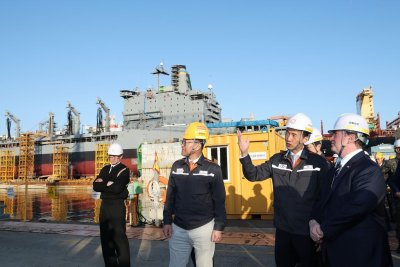Hanwha Group Vice
Chairman Kim Dong-kwan, second from right, explains the conglomerate’s
shipbuilding facilities to US Navy Secretary John Phelan, far right, at Hanwha’s
Geoje shipyard in South Korea, Wednesday. Photo courtesy of Hanwha Ocean
May 3 (UPI) — South Korea’s defense industry is gaining global interest, as demonstrated by high-profile visits from U.S. figures like Donald Trump Jr., who met with business leaders in Seoul Tuesday. Reportedly, among them was Hanwha Group Vice Chairman Kim Dong-kwan.
Vice Chairman Kim also hosted US Navy Secretary John Phelan Wednesday at Hanwha’s shipyard in Geoje, roughly 200miles southeast of Seoul.
“Working with leading shipyards like Hanwha Ocean Shipbuilding and HD Hyundai Heavy Industries is essential to ensuring deployed U.S. ships and systems remain fully operational in the Indo-Pacific,” Secretary Phelan said.
“Leveraging the expertise of these highly capable shipyards enables timely maintenance and repairs for our vessels to operate at peak performance. This level of large-scale repair and maintenance capability strengthens our combat readiness, sustains forward deployed operational presence, and reinforces regional stability,” he stated
Observers point out that such visits reflect growing global recognition of South Korea’s defense capabilities.
Hanwha Group operates such subsidiaries as Hanwha Aerospace, known for the K9 self-propelled howitzers, and Hanwha Ocean, a manufacturer of warships and submarines.
As the eldest son of Chairman Kim Seung-youn, Vice Chairman Kim is regarded as the heir apparent of South Korea’s seventh-largest conglomerate.
“For the United States, South Korea is indispensable to reviving its shipbuilding industry, as President Donald Trump has stressed,” Seoul-based consultancy Leaders Index CEO Park Ju-gun told UPI.
“Washington is likely to seek South Korea’s capital and technology as the country is a global leader in naval vessel construction. Hanwha Ocean is well-positioned, having already invested in the U.S. last year,” he said.
In June 2024, Hanwha Ocean and its sister company channeled $100 million to acquire Philly Shipyard, which has delivered about half of the large U.S. Jones Act commercial ships since 2000.
Hanwha Ocean was soon awarded a maintenance, repair, and overhaul (MRO) contract for the U.S. Navy’s dry cargo and ammunition ship Wally Schirra.
The task was completedin Geoje and Hanwha Ocean is now working on another MRO deal for USNS Yukon, a replenishment oiler assigned to the Navy’s 7th Fleet.
Beyond the U.S., the traditional weapons of South Korea gained popularity after the war between Russia and Ukraine started in early 2022.
According to South Korea’s defense ministry, arms exports more than doubled from $7.73 billion in 2021 to $17.3 billion in 2022. The figure dropped to $13 billion in 2023 and $9.5 billion last year, but is projected to rebound to $24 billion this year in consideration of ongoing negotiations with multiple countries.
In addition to Hanwha, several other South Korean defense corporations have proactively entered the global market, including Hyundai Rotem, Korea Aerospace Industries, LIG Nex1, and HD Hyundai.
“South Korean firms are favored by global buyers for their quick delivery and cost-effectiveness, the advantages shaped by the country’s continued weapons production amid North Korean threats,” Jeonbuk National University professor Jang Won-joon said in a phone interview.
“Their international rivals are also trying to expand facilities to better meet demand. Against this backdrop, South Korean players will need to innovate to maintain their edge in the long run,” he commented.
However, some critics take issue with the Seoul administration’s lack of transparency in arms exports.
“The Korean government vows to become one of the world’s top four arms exporters. Yet, it does not disclose related information transparently,” attorney Lim Jae-sung noted in a local newspaper column.
